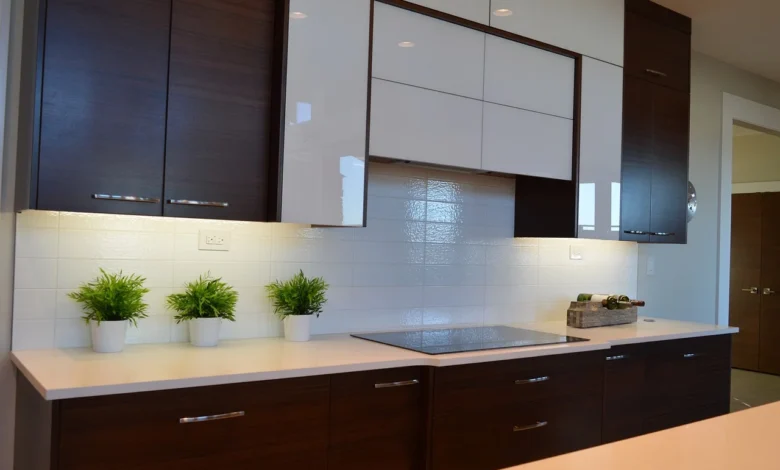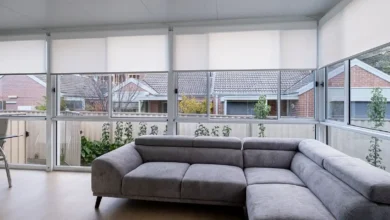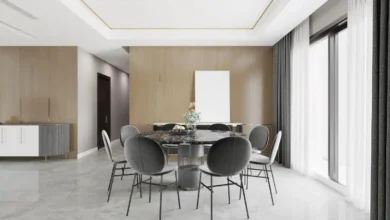
The kitchen is often considered the heart of the home, where families gather to cook, eat, and socialize. Decorating your kitchen not only makes it a more inviting and enjoyable space, but it can also increase the overall value of your home. There are a variety of ways to decorate your kitchen, from simple updates like new cabinet hardware to more extensive renovations like new countertops or flooring. You can also add personal touches like artwork, houseplants, or a colorful backsplash. The possibilities are endless; here in this short tutorial, we have summarized some modern kitchen decor ideas and tips.
Opt For Clean Lines and Minimalism
Modern kitchens tend to be sleek and uncluttered, with simple, straight lines and a focus on functionality. When choosing furnishings and fixtures, look for pieces with clean, angular shapes and neutral colors.
Minimalism in kitchen decoration creates a modern and stylish space that is both functional and aesthetically pleasing. By focusing on clean lines, neutral colors, and functional elements, minimalism allows for a space that is both practical and visually appealing.
Use Monochromatic Color Schemes
A monochromatic color scheme, such as all whites, grays, or black and white, can give a modern kitchen a sophisticated and cohesive look. You can also opt for a two-tone color scheme, such as white cabinets and black countertops, for a more interesting look.
Incorporate Natural Materials
Natural materials, such as wood, stone, and metal, can bring a touch of warmth to a modern kitchen and help balance the clean lines and sleek surfaces. Metals like stainless steel, brass, and copper can also add a touch of glamour to a modern kitchen. Consider installing metallic cabinet hardware, light fixtures, or a metal backsplash for a modern look.
Play with Textures
To add interest to a modern kitchen, consider incorporating different textures, such as a rough-hewn wooden island, a smooth marble countertop, or a textured backsplash.
Invest In Energy-Efficient Appliances
Modern kitchens are all about functionality, and energy-efficient appliances can help keep your kitchen running smoothly while also reducing your energy costs.
Some common energy-efficient appliances in the kitchen include:
Refrigerators: Energy-efficient refrigerators have improved insulation, better sealing, and more precise temperature control systems, which help to reduce energy consumption.
Dishwashers: Energy-efficient dishwashers use less water and have improved wash cycles that use less energy. Many models now have a “delay start” feature, which allows you to run the dishwasher during off-peak hours when energy prices are lower.
Ovens: Energy-efficient ovens have improved insulation and more precise temperature control systems, which help to reduce energy consumption. Some models also have a convection cooking option, which circulates hot air to cook food more evenly and quickly, reducing cooking time and energy use.
Cooktops: Energy-efficient cooktops use less energy and have more precise temperature control systems. Induction cooktops, in particular, are highly energy-efficient as they heat pots and pans directly, reducing heat loss and energy consumption.
Microwaves: Energy-efficient microwaves use less energy and have improved heating systems, which reduce cooking time and energy use.
When choosing energy-efficient appliances for your kitchen, it’s important to look for appliances with the ENERGY STAR label, which indicates that they meet strict energy efficiency guidelines set by the U.S. Environmental Protection Agency.
By incorporating energy-efficient appliances into your kitchen, you can help reduce your carbon footprint and lower your energy bills. Additionally, by using these appliances you can help to conserve energy and protect the environment for future generations.
Add Statement Lighting
Lighting is an important aspect of any kitchen, and modern kitchens can benefit from statement lighting fixtures, such as pendant lights, chandeliers, or track lighting. Consider installing lighting under cabinets or in the ceiling to add a modern touch and improve functionality in your kitchen.
Choose Modern Cabinets
Cabinets play a big role in the overall look and feel of a kitchen. Consider installing flat-panel, high-gloss cabinets in a neutral color like white or gray. Sleek stainless steel handles or knobs will add a modern touch.
Common materials used for modern kitchen cabinets include engineered wood, such as MDF or particleboard, and natural materials such as solid wood or stone. Engineered woods are often used because they are more affordable and easier to work with than natural woods, while natural materials such as solid wood or stone are favored for their durability and timeless beauty.
When it comes to color, modern kitchen cabinets often feature neutral tones such as white, gray, or black. These colors create a clean and modern look and provide a neutral backdrop for other design elements. However, bolder colors, such as blue or red, can also be used to create a statement and add visual interest to the space.
Invest In High-Quality Countertops
Countertops are another important aspect of a kitchen, and modern kitchens often feature countertops made of materials like quartz, granite, or concrete. These materials are durable, low-maintenance, and available in a range of colors and patterns.
Utilize Open Shelving
Open shelving is a popular feature in modern kitchens, as it can create a clean, minimal look while also allowing you to display your favorite dishes, glasses, and cooking tools. This style can offer a number of benefits, including:
Increased storage space: Open shelving can provide additional storage space in a kitchen, especially when there’s limited cabinet space.
Improved organization: With open shelving, it’s easier to see what items you have on hand and where they are located, which can help you stay organized and make it easier to find what you need.
Aesthetic appeal: Open shelving can add a decorative touch to your kitchen and create a stylish, modern look. You can use the shelves to showcase colorful dishes, interesting glassware, and other decorative items.
Increased accessibility: Open shelving makes it easier to access items in your kitchen, as you don’t have to dig through cabinets to find what you need.
However, there are also some potential downsides to open shelving. Dust and grease can be collected on items displayed on open shelves, and it can be more difficult to keep everything looking neat and tidy. If you have young children, you may also need to be careful about what items you store on open shelves to prevent them from reaching dangerous items.
Incorporate Plants
Adding greenery to your kitchen can bring a touch of nature and life to the space. Consider placing a few houseplants on shelves, windowsills, or countertops for a modern and natural look.
By incorporating these details into your modern kitchen design, you can create a stylish, functional, and modern space that you and your family will love for years to come.
Final Words
Decorating a modern kitchen requires careful consideration of various elements, from the color scheme and countertops to the lighting and hardware. By incorporating modern design elements, such as sleek cabinets, monochromatic color schemes, high-quality countertops, and statement lighting fixtures, you can create a stylish and functional modern kitchen that reflects your personal style and meets your needs.
Don’t be afraid to get creative and think outside the box, and don’t forget to incorporate functional elements, such as smart storage solutions and energy-efficient appliances, to ensure your kitchen is both beautiful and functional. With the right design elements and attention to detail, you can create a modern kitchen that you will love for years to come.
We hope you found this article helpful. If you did, be sure to check out our blog for more great content like this.





